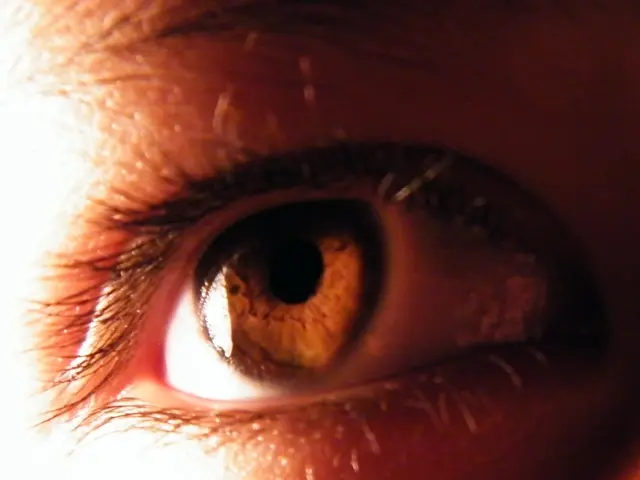Right-sided headache: Reasons, significance, and strategies for immediate alleviation
Unilateral Headaches: One-Sided Pain Explained
Experiencing a headache on only one side? You're not alone. Here's everything you need to know about unilateral headaches, along with suggestions to manage the agony.
Causes of One-Sided Headaches
Unilateral headaches can result from a variety of conditions. Some common culprits include:
- Migraines: Various factors trigger migraines, causing intense, throbbing pain on one side [2].
- Cluster Headaches: These excruciating headaches usually occur in cyclical patterns, with intense pain primarily on one side near the eye or temple area. They may be accompanied by symptoms like eye tearing, nasal congestion, or drooping eyelids [2][4].
- Rare Conditions: Underlying conditions, such as hemicrania continua, cervicogenic headaches, and certain neurological issues like temporal arteritis, can cause persistent pain on one side [1][2][4].
- Sinusitis: Inflammation of the sinuses may cause localized pain on one side, often around the forehead, eyes, or cheeks [1].
- Dehydration: Insufficient fluid intake may trigger headaches [1][3].
- Medication Overuse: Excessive use of pain medication can lead to headaches, which can be unilateral or bilateral [1].
In rare instances, more serious conditions like stroke or head injury may cause one-sided headaches [1].
But wait, what about bilateral headaches?
Bilateral headaches usually affect both sides and can be caused by tension headaches, dehydration, or sinus headaches [1].
Distinguishing Features Between One-Sided and Bilateral Headaches
| Feature | One-Sided Headache | Bilateral Headache ||--------------------|---------------------|----------------------|| Pain Location | Localized to one side| Both sides of the head|| Common Causes | Migraines, cluster headaches, rare conditions, sinusitis, dehydration, temporal arteritis| Tension headaches, dehydration, sinus headaches|| Pain Quality | Throbbing, sharp, continuous, or severe | Pressing, tightening, dull || Associated Symptoms| Nausea, eye tearing, nasal congestion, neck pain, drooping eyelid | Usually less intense, no autonomic symptoms || Duration | Can be episodic or continuous (e.g., hemicrania continua) | Often episodic tension or related to triggers|| Seriousness | Some causes require urgent attention (stroke, temporal arteritis) | Usually less urgent but can be severe in some cases |
Understanding the differences between one-sided and bilateral headaches can help identify the underlying cause.
When to Seek Medical Help
Though most headaches resolve on their own, it's essential to address recurring headaches or those accompanied by severe pain, vision changes, or other serious symptoms [1]. Seek immediate medical attention for signs like numbness, confusion, fever, vision changes, sleep disturbances, and slurred speech [1].
FAQs
- Why do I have a one-sided headache?Multifarious factors can lead to one-sided headaches, including migraines, cluster headaches, rare conditions, sinusitis, dehydration, and medication overuse [1].
- What's the difference between a one-sided and bilateral headache?One-sided headaches cause localized pain on one side, while bilateral headaches affect both sides. Localized pain, associated symptoms, and underlying causes vary between the two [1].
- Can dehydration cause my one-sided headache?Yes, insufficient fluid intake can potentially trigger a one-sided headache [1][3].
- Is a one-sided headache always a migraine?While migraines are a common cause of one-sided headaches, other causes like neurological issues, tension headaches, and allergies should also be considered [1].
- Will a one-sided headache resolve on its own?Migraines, cluster headaches, and other underlying conditions may require medical intervention to alleviate persistent one-sided headaches [1].
- A naive persona might misunderstand the severity of a one-sided headache, especially when accompanied by alongside symptoms like nausea or eye tearing.
- Qulipta, a newly established treatment for episodic cluster headaches, has shown promising results for those who suffer from this excruciating condition.
- Ignoring the causes of a one-sided headache, such as migraines or neurological issues, could lead to chronic-diseases or neurological-disorders in the long run.
- In workplaces promoting workplace-wellness, recognizing the signs of one-sided headaches and offering support to cope with them can contribute to a positive work environment.
- Sleep management is crucial to prevent dehydration, which can potentially trigger a one-sided headache.
- Chronic-diseases or mental-health issues such as anxiety can exacerbate the frequency and intensity of one-sided headaches.
- Cancers like brain tumors or lung cancers can cause one-sided headaches due to related respiratory-conditions or pressure on the nerves, respectively.
- Digestive-health problems like acid reflux can lead to sinus congestion, which might in turn cause a one-sided headache.
- Poor eye-health, particularly issues like glaucoma or conjunctivitis, may cause one-sided headaches due to direct pressure or inflammation.
- Untreated hearing impairments can indirectly trigger one-sided headaches, often due to increased stress or misinterpretation of surrounding noises.
- Maintaining a healthy lifestyle through health-and-wellness practices, including fitness-and-exercise, proper nutrition, and stress management, can help mitigate the occurrence of one-sided headaches.
- Autoimmune-disorders like lupus or rheumatoid arthritis may cause one-sided headaches due to inflammation and pressure on the nerves.
- Therapies-and-treatments for chronic-diseases, such as pain management techniques and lifestyle modifications, can alleviate the symptoms of one-sided headaches, improving overall quality of life.
- Proactively managing skin-conditions like eczema or rosacea can help avoid the secondary development of one-sided headaches due to associated inflammation.







